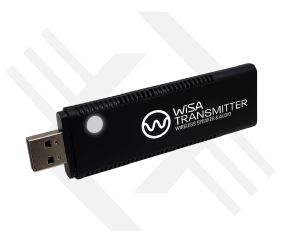WiSA is a wireless digital audio transmission standard. Originally developed as a standard for high quality sound transmission, it supports 8 sound channels, which allows you to equip your room with 7.1 sound speakers. From 2020 it supports the Dolby Atmos standard.
Requirements for devices that support WiSA
There are no special requirements, a device that transmits sound must have a special WiSA audio transmitter. The loudspeaker system has WiSA receivers in each speaker. Also, the device acting as a transmitter must be software capable of working with WiSA.
How WiSA works
WiSA uses the 5 GHz band like WiFi, but has a different encoding, the transmission is carried out over 24 channels of the 5 GHz band. Three channels per audio channel. The special encoding provides quite a high transmission speed. In addition, the software devices must be able to work with WiSA protocol. In general, it works like this, there is a TV with support for WiSA and acoustics, such as standard 7.1, each speaker is tied to the place of installation, front, side left and so on. When the broadcast is turned on, the WiSA transmitter in the TV receives the audio stream encoding and transmits the sound channel to the specific loudspeaker. Acoustic speaker is a receiver tuned to a certain channel, it receives the radio signal and decodes the sound.
Advantages and disadvantages of WiSA
- The main advantage is the absence of wires for sound transmission, so the developers say. But in practice it is not quite so, in WiSA all speakers are active, they should be connected to the electric network.
- Lack, small radius of Wisa, due to the fact that a fairly high range is used, the radio signal is lost. For WiSA speakers to work properly, they must be within 10 meters (30 feet) of the transmitter.
- There is a delay in the playback of the sound, when the sound is broadcast. As the developers say it’s not much, a delay of only 1/10 of the time of sound processing through the Bluetooth. But the delay is still there and if the acoustics is used only for listening to audio it’s not critical, but it’s quite different in TVs, when watching video it’s not comfortable when the sound is not consistent with the movement of the lips of actors. Manufacturers compensate for this inconvenience by delaying video playback for the time it takes the acoustics to encode, transmit and decode the audio signal.
The Future of WiSA
It’s hard to say anything, the new WiFi standards also allow you to transmit high-quality sound. Not many companies support WiSA. For example, LG has some televisions that support WiSA, but to make production cheaper, only the software part of WiSA work is implemented, but the TV does not have a transmitter. Therefore, LG TVs are designed to work with complete audio systems (which include not only speakers, but also a transmitter) or you should buy a WiSA transmitter. Such devices are quite expensive.






